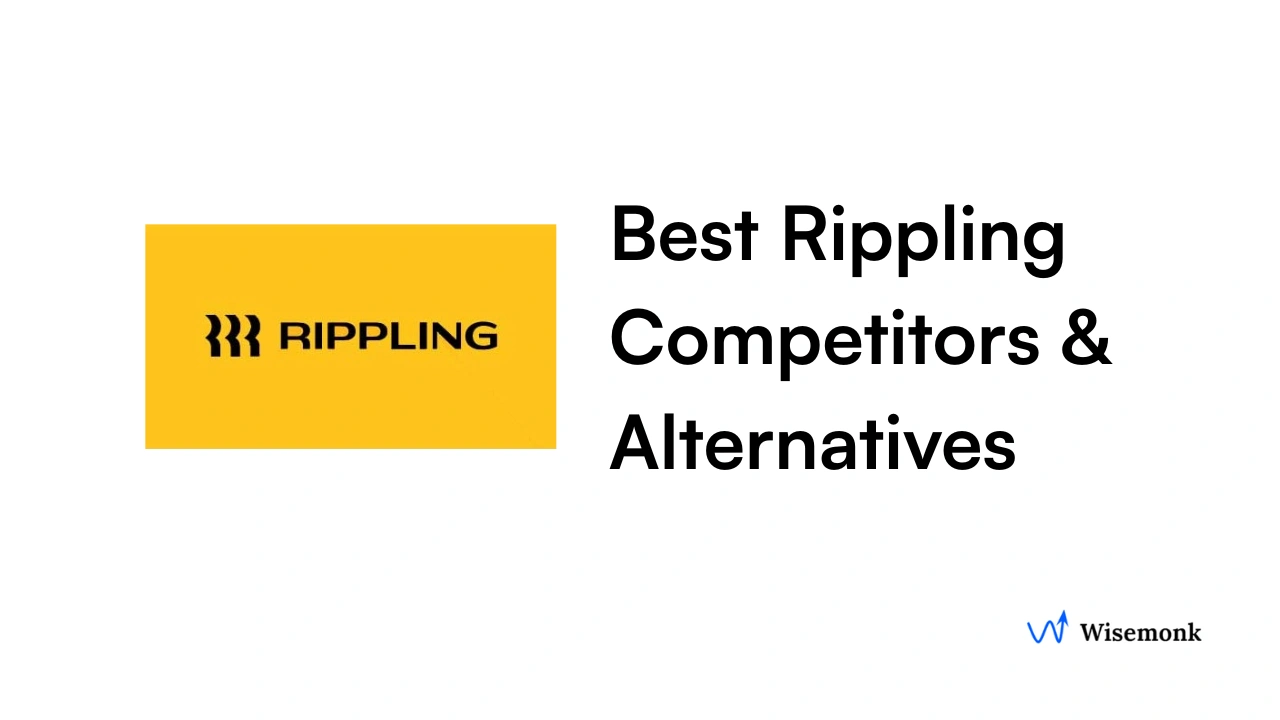- Workplace compliance means following federal, state, and local laws related to labor, data security, and employee rights. Failing to comply can result in fines, legal risks, and harm to your company’s reputation.
- Key strategies for managing compliance include conducting regular audits, having clear policies, providing ongoing training, and using real-time monitoring.
- Businesses must address changing regulations, data protection laws, and compliance challenges across different regions
Are you overwhelmed by the constant changes in workplace compliance laws in the US? With evolving labor regulations, tax requirements, and employee rights, staying compliant can often feel like a daunting task. Non-compliance can lead to costly penalties, legal disputes, and a damaged reputation.
That's why ensuring your workplace compliance is more important than ever. By understanding key regulations and implementing the right strategies, you can protect your business from these risks and create a positive, legally compliant work environment.
In this blog, we’ll explore essential workplace compliance tips that will help you navigate US laws and safeguard your organization from potential legal issues.
What is Workplace Compliance?
Workplace compliance refers to adhering to federal, state, and local laws and regulations governing labor standards, employee rights, data security, workplace safety, and privacy, which is mandatory for all organizations to avoid legal risks and penalties.
Importance of Workplace Compliance
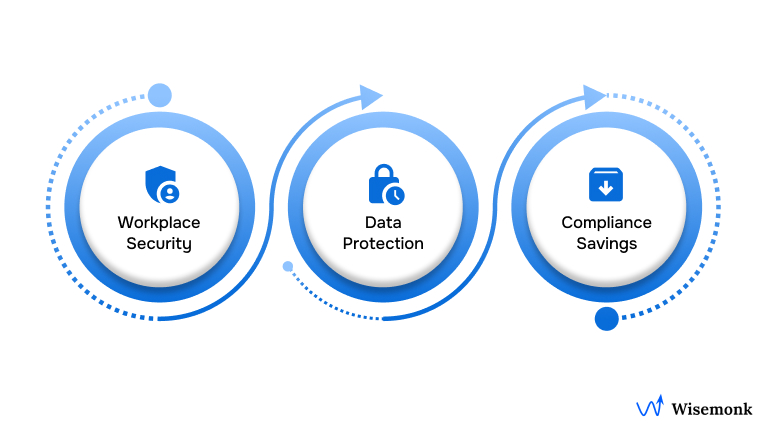
Workplace compliance involves continuous processes including regular policy evaluation, employee training, and data protection measures to safeguard your business, employees, and sensitive information. Companies must continuously evaluate and update corporate policies and procedures to maintain compliance.
Here are some of the reasons why workplace compliance is inevitable in an organization:
1 Securing Your Workplace & Data
Maintaining workplace compliance is essential for safeguarding sensitive data and securing operations by ensuring employees across all departments follow proper protocols, reducing risks of data breaches and security threats.
Here are some examples of sensitive data handled by various teams:
- Finance: Personal addresses, credit card details, and bank account numbers
- Marketing: Email addresses, browsing data, and social media activity
- HR: Social security numbers, contact details, and employee demographics
- Operations: Customer names, purchasing histories, and visitor logs
Ensuring compliance at every level reduces the risk of data breaches and security incidents
2 Protects Sensitive Information
Businesses must secure restricted information and limit access to authorized personnel, as non-compliance with data protection regulations can cause severe penalties and reputational harm.
Here are key practices for protecting sensitive information:
- Access Control: Limit data access to authorized personnel only
- Visitor Logs: Track and secure access to sensitive areas
- Data Encryption: Ensure data is encrypted both in transit and at rest
- Regular Audits: Conduct periodic audits to ensure compliance with security protocols
Failure to adhere to these practices can result in hefty penalties and long-lasting damage to your business relationship.
3 Saving the Cost of Non-compliance
Non-compliance can be costly for businesses, with the average cost reaching around $14.82 million due to fines, operational disruptions, and loss of business opportunities. Beyond lost revenue, it can impact various aspects of your business, often with hidden financial repercussions.
Here are some of the hidden costs of non-compliance:
- Fines, Penalties, and Fees: Heavy financial burdens from regulatory authorities
- Business Disruption: Operational delays and loss of efficiency
- Contract or Business Partner Loss: Damaged relationships with clients and partners
- Productivity Loss: Time spent addressing compliance issues instead of core activities
- Loss of Assets: Potential loss of intellectual property or valuable company assets
- Reputation Damage: A tarnished brand image that can drive away customers and talent
Addressing compliance proactively helps you avoid these costly risks and safeguard your company’s financial health. By prioritizing workplace compliance, you can also cultivate a secure and trustworthy environment for both employees and clients.
Now, let's explore the different types of workplace compliance frameworks that can help structure your compliance efforts effectively.
Types of Workplace Compliance Frameworks
Workplace compliance involves following various regulations that apply to different aspects of a business, such as employee welfare, data security, financial transparency, and environmental responsibility. The specific compliance frameworks a business must adhere to depend on the industry and its operations. Below are some of the most common compliance frameworks businesses need to be aware of to ensure legal and ethical operations.
Here are some of the most common workplace compliance frameworks:
- Medicare & Medicaid Act: Compliance with federal health insurance offerings for employees.
- Clean Water Act (CWA) & Clean Air Act (CAA): Regulations for businesses impacting water and air quality, such as manufacturers and construction companies.
- Anti-Money Laundering Act (AML): Required for financial institutions to monitor and report suspicious activities.
- Federal Information Security Modernization Act: Mandates robust cybersecurity measures for federal contractors.
- General Data Protection Regulation (GDPR): Protects personal data of EU citizens and requires consent for data collection.
- Health Insurance Portability and Accountability Act (HIPAA): Protects patient data in healthcare organizations.
- Employment Laws and Regulations: Ensures fair pay, benefits, and safe working conditions for all employees.
- Taxation Laws: Compliance with tax laws for accurate employee taxation.
- ISO/IEC 27001: Strong data security processes for protecting company information.
- Occupational Safety and Health Act (OSHA): Ensures safe and ergonomic workspaces for employees.
- Payment Card Industry Data Security Standard (PCI DSS): Regulations for businesses handling online transactions to protect payment data.
- Service Organization Controls (SOC) 1 & 2: Requirements for strong financial reporting and data privacy practices.
- Sarbanes-Oxley Act: Enforces timely and accurate financial disclosures for publicly traded companies.
By understanding these frameworks, businesses can avoid costly non-compliance and protect both the company and its stakeholders.
Achieving Workplace Compliance: A Step-by-Step Guide
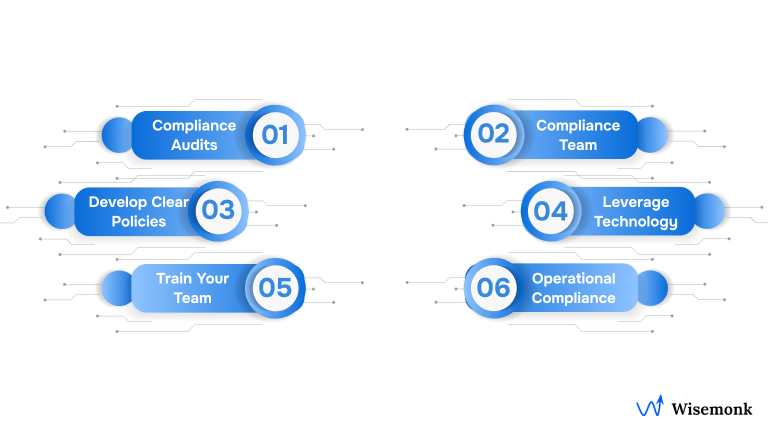
Workplace compliance is a crucial component of a successful business strategy. By being proactive and following a structured approach, you can ensure that your workplace meets all necessary regulations and fosters an environment where employees can thrive.
Here are the essential steps to achieve and maintain compliance:
1 Conduct Compliance Assessments
Regularly assess applicable regulations for your business and track industry changes. Staying updated will help you avoid legal risks. For example, healthcare businesses must comply with HIPAA, while businesses dealing with EU citizens must follow GDPR guidelines.
2 Create a Compliance Crew
Appoint a dedicated team or individual to oversee compliance efforts. Key roles include:
- Compliance Manager: Manages internal policies and ensures alignment with regulations.
- Data Protection Officer: Oversees data privacy and security.
- Risk Management Officer: Identifies compliance risks and mitigates them.
3 Develop Clear Policies
Create detailed compliance policies that outline required procedures and ensure legal adherence. Accessible and clear policies help prevent violations and protect against legal consequences.
4 Leverage Technology
Use specialized software to help manage compliance effectively. Technology can streamline processes and improve organization, making it easier to stay compliant. For example, using compliance management software that monitors employee collaboration and workspace usage can help maintain adherence to regulatory standards by providing real-time insights and alerts.
5 Train Your Team
Regular employee training on compliance is essential to avoid costly mistakes. Keeping your workforce informed and up-to-date on evolving regulations reduces the likelihood of non-compliance incidents.
6 Embed Compliance into Operations
Make compliance an ongoing part of your operational culture. Use the right tools and processes to integrate compliance seamlessly into your business, ensuring it’s not a one-time task but an ongoing commitment.
Following these steps will not only help your business meet its compliance obligations but also create a solid foundation for long-term success.
What are Common Compliance Challenges?
Workplace compliance involves following laws and regulations to ensure that a business operates legally, ethically, and securely. It includes everything from employee rights and data protection to financial transparency and environmental responsibility. As laws and regulations evolve, businesses face challenges in keeping up with changes and ensuring they stay compliant.
Below are some of the most common compliance challenges businesses encounter:
- Staying on Top of Changing Regulations: Regulations frequently change, requiring businesses to stay informed and adjust policies accordingly.
- Frequent Legal Updates: New laws and industry standards emerge regularly, making continuous monitoring essential for staying compliant.
- Multi-Jurisdictional Compliance: Companies operating across different regions must navigate varying legal frameworks, complicating compliance efforts.
- Limited Compliance Expertise: Organizations without dedicated legal teams often struggle to interpret complex regulations and ensure compliance.
- Inconsistent Enforcement: Departments within the same organization may apply compliance policies unevenly, leading to gaps in adherence.
- Ensuring Data Security and Privacy: Stringent data protection laws require robust security measures to prevent breaches and unauthorized access.
- Rising Cyber Risks: Increasing threats like phishing and ransomware demand proactive security measures to safeguard sensitive data.
- Third-Party Data Handling Risks: Vendors and third parties with access to sensitive information must also comply with the same security standards.
- Data Governance Complexities: Proper data classification, retention, and disposal policies are necessary to avoid non-compliance in managing sensitive information.
- Evolving Technologies: The use of cloud storage and AI systems introduces new security vulnerabilities, making compliance efforts even more challenging.
Businesses must adopt a proactive approach, using automated systems and regular audits to ensure continuous compliance and minimize risks.
Essential Tips for Managing Workforce Compliance
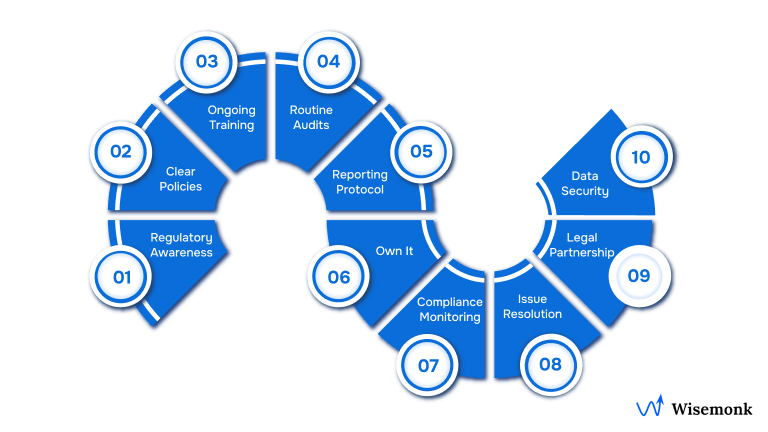
Managing workforce compliance is critical to avoid legal and financial risks while fostering a safe and ethical work environment. Here are some essential tips to help ensure your organization stays compliant and resolves issues efficiently:
- Understand and Stay Updated on Regulations
Continuously monitor changes in laws and regulations to avoid non-compliance penalties. Regularly check government bulletins, industry news, and consult legal experts to stay informed on any updates or changes. - Develop Clear, Written Policies
Create and maintain comprehensive written policies outlining compliance expectations and legal responsibilities. Make these policies accessible to all employees and update them regularly to reflect changes in regulations. - Invest in Regular Training Programs
Ongoing training for employees is crucial for keeping everyone aware of compliance expectations. Ensure training programs are mandatory, updated regularly, and include testing to confirm understanding. - Conduct Regular Audits and Inspections
Regular audits, both internal and external, help identify compliance risks early. Focus audits on critical areas such as financial reporting, safety standards, and data privacy to ensure compliance is maintained. - Establish a Clear Reporting Process
Create a transparent system for employees to report compliance concerns. An anonymous reporting channel encourages employees to voice issues without fear of retaliation, enabling timely resolution of potential problems. - Create a Culture of Accountability
Foster an environment where compliance is everyone’s responsibility. Management should lead by example, and employees should understand their role in maintaining compliance. - Monitor and Track Compliance Continuously
Use compliance management systems or software to track key compliance metrics, audit results, and training completion. Regular monitoring ensures that your organization remains compliant and helps address issues proactively. - Address Compliance Issues Immediately
Act quickly to resolve any compliance issues as soon as they are identified. Immediate action prevents escalation, minimizes risks, and ensures that problems are dealt with efficiently. - Work Closely with Legal and Compliance Experts
Collaborate with legal and compliance professionals to navigate complex regulations and industry-specific requirements. Their expertise helps ensure that your compliance efforts are effective and up-to-date. - Review and Strengthen Data Protection Practices
Implement robust data protection measures, especially if you handle sensitive customer or employee information. Stay compliant with regulations like GDPR and HIPAA and educate employees on secure data handling practices.
Follow these tips to successfully manage workforce compliance and protect your organization from potential legal or financial issues.
Wrapping UP
Achieving and maintaining workplace compliance is crucial for safeguarding your organization against legal, financial, and reputational risks. By understanding the various compliance frameworks, implementing best practices, and staying informed on changing regulations, businesses can create a secure and compliant environment. Proactively managing compliance not only minimizes risks but also fosters trust and accountability across the workplace.
However, managing compliance becomes more challenging when operating overseas, as different countries have varying legal frameworks. Navigating local labor laws, tax codes, and regulations can be complex. Wisemonk simplifies this by providing comprehensive Employer of Record (EOR) services, ensuring full compliance across international operations. Our compliance services cover everything from tax filings to employee rights, allowing you to focus on your core business activities.
Ready to simplify your compliance management? Check out our competitive pricing and see how we can help your business thrive globally. Contact us today to discover how Wisemonk can help you navigate compliance with ease!
FAQs
1. What is the meaning of workforce compliance?
Workforce compliance refers to adhering to labor laws, regulations, and policies that govern how employees are treated, paid, and managed within an organization.
2. What are the 7 elements of compliance?
The seven elements of compliance encompass leadership commitment, policy development, employee training, regular auditing, monitoring systems, effective communication, and corrective actions to maintain compliance.
3. What are the 5 keys of compliance?
The five keys of compliance involve strict adherence to regulations, consistent enforcement of policies, clear and accessible policies, comprehensive employee training, and conducting regular audits.
4. What are the three pillars of compliance?
The three pillars of compliance include ethics, rules and regulations, and enforcement. These pillars help ensure the organization operates within legal and ethical boundaries.
5. What are the 4 levels of compliance?
The four levels of compliance are foundational compliance, regulatory compliance, strategic compliance, and transformative compliance, each offering varying degrees of adherence to laws.
6. How can compliance affect business operations?
Non-compliance can lead to fines, legal disputes, and reputational damage, negatively impacting business operations, revenue, and employee morale.
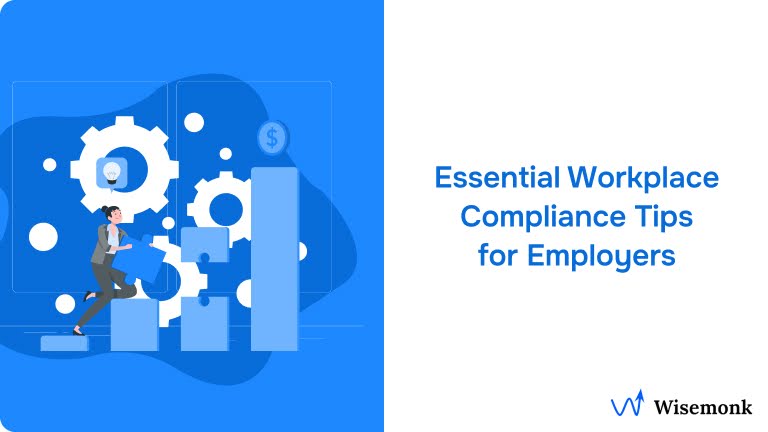




%20(3).webp)
%20(2).webp)
